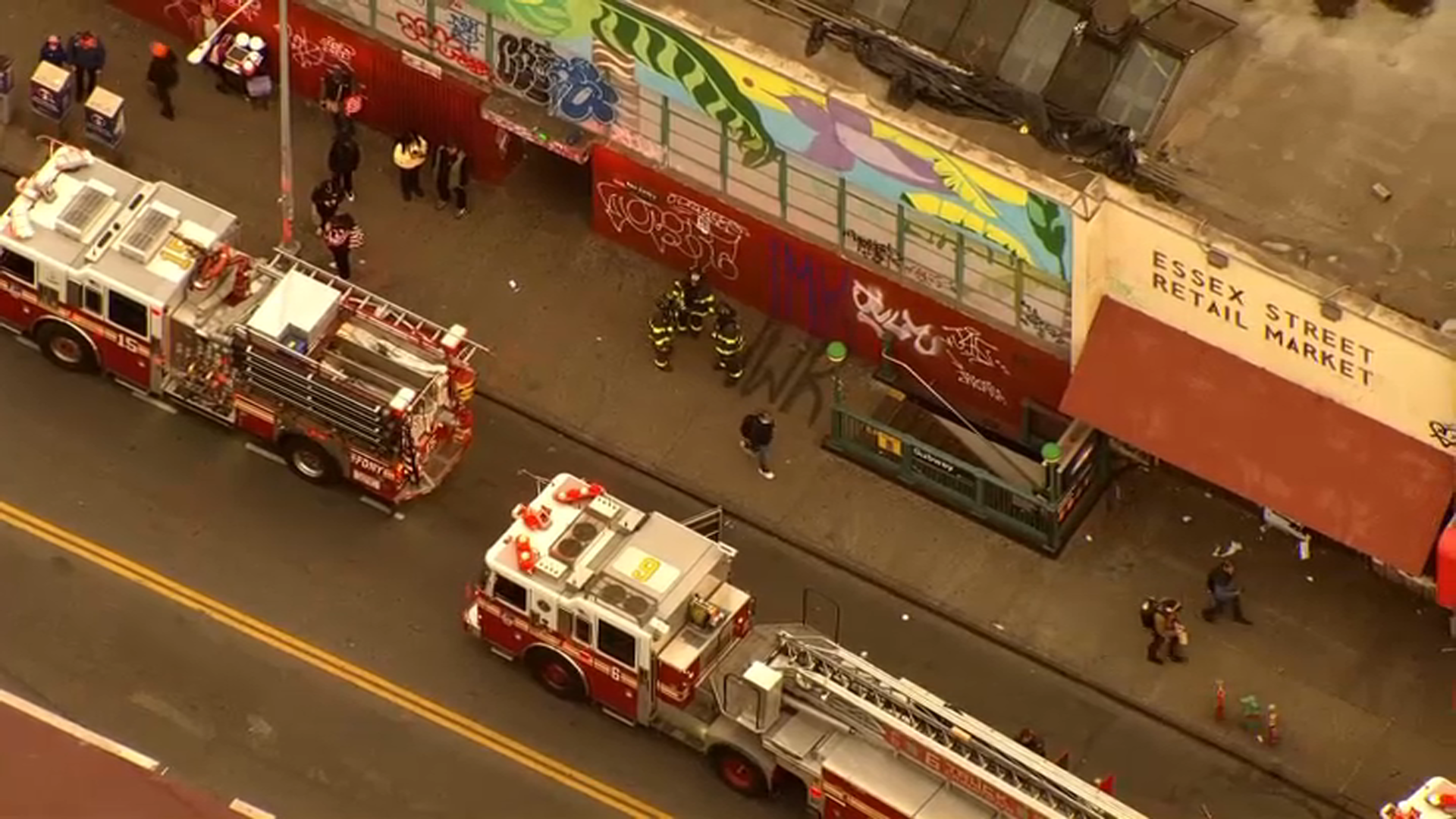Flooding is the most common natural disaster in the U.S. -- because of this, it is important for you to know what to do before, during and after you are caught in a flood event, including a flash flood.
Scroll for a complete guide on what you should know if you find yourself in a flooding situation. For the latest Storm Team 4 forecast update and more on the powerful storm hitting America now, click here.
WHAT IS FLOODING, A FLOOD WATCH AND A FLOOD WARNING?
Flooding, as defined by the National Weather Service, is the temporary overflow of water onto land that is normally dry.
A subcategory of flooding is that of a flash flood, which essentially is a sudden and violent flood that can take mere minutes to hours to develop. Keep in mind that it is possible to experience a flash flood in areas that did not immediately receive rain.
But what is the difference between a Flood Watch and a Flood Warning issued by the National Weather Service? According to NWS:
Get Tri-state area news delivered to your inbox. Sign up for NBC New York's News Headlines newsletter.
- Flash Flood Warning: Take Action! A Flash Flood Warning is issued when a flash flood is imminent or occurring. If you are in a flood-prone area move immediately to high ground. A flash flood is a sudden violent flood that can take from minutes to hours to develop. It is even possible to experience a flash flood in areas not immediately receiving rain.
- Flood Warning: Take Action! A Flood Warning is issued when the hazardous weather event is imminent or already happening. A Flood Warning is issued when flooding is imminent or occurring.
- Flood Watch: Be Prepared: A Flood Watch is issued when conditions are favorable for a specific hazardous weather event to occur. A Flood Watch is issued when conditions are favorable for flooding. It does not mean flooding will occur, but it is possible.
- Flood Advisory: Be Aware: An Flood Advisory is issued when a specific weather event that is forecast to occur may become a nuisance. A Flood Advisory is issued when flooding is not expected to be bad enough to issue a warning. However, it may cause significant inconvenience, and if caution is not exercised, it could lead to situations that may threaten life and/or property.
PREPARING FOR A FLOOD
News
Ready.gov, a national public service campaign launched in 2003 to educate on how to prepare for, respond to and mitigate natural and man-made disasters emergencies, says that preparing for a flood includes "making a plan for your household, including your pets, so that you and your family know what to do, where to go, and what you will need to protect yourselves from flooding. Learn and practice evacuation routes, shelter plans, and flash flood response. Gather supplies, including non-perishable foods, cleaning supplies, and water for several days, in case you must leave immediately or if services are cut off in your area."
It is also important to store vital documents in a waterproof container, as well as set up password-protected digital copies, Ready.gov advises, adding that valuables should be moved to higher levels, drains and gutters should be decluttered, and that check valves should be installed. Ready.gov also advises a sump pump with a battery to move water from your basement out of your home.
Additionally, if you live in an area prone to flooding, a flood insurance policy is recommended. Keep in mind that homeowner’s insurance policies do not cover flooding and it usually takes up to 30 days for a policy to go into effect so make sure to purchase the policy before a disaster, according to Ready.gov.
WHAT TO DO DURING A FLOOD?
Water levels and water flow rates can change quickly and without warning during a flood.
Because of this, the NWS advises everyone to remain vigilant and informed by monitoring local weather conditions through radio or television, as well as through local alerting systems for current emergency information and instructions regarding flooding.
According to the National Weather Service, during a flood:
- Stay Informed: Listen to radio and television, including NOAA Weather Radio if possible, check the Internet and social media for information and updates.
- Get to Higher Ground: If you live in a flood-prone area or are camping in a low-lying area, get to higher ground immediately.
- Obey Evacuation Orders: If told to evacuate, do so immediately. Lock your home when you leave. If you have time, disconnect utilities and appliances.
- Practice Electrical Safety: Don't go into a basement, or any room, if water covers the electrical outlets or if cords are submerged. If you see sparks or hear buzzing, crackling, snapping or popping noises--get out! Stay out of water that may have electricity in it!
- Avoid Flood Waters: Don't walk through flood waters. It only takes 6 inches of moving water to knock you off your feet. If you are trapped by moving water, move to the highest possible point and call 911 if possible. Do NOT drive into flooded roadways or around a barricade.
New Jersey's Office of Emergency Management also lists basic safety tips about flooding, including:
- Avoid areas that are already flooded, and areas that are subject to flooding. Seek higher ground.
- Never try to drive through swift water.
- Never ignore barriers that warn of flooded or dangerous roads.
- If floodwaters rise around your car or the car stalls, abandon the car and move to higher ground if you can do so safely. Many deaths occur when people and cars are swept away by floodwaters.
- Do not park or camp along streams and other bodies of water, especially during threatening conditions.
- Be extra careful at night when it is harder to recognize flood dangers.
- Do not walk across a flowing stream if the water is higher than your ankles. If you encounter this, stop, turn around and go another way.
- Never try to walk or swim through swift water, instead seek higher ground.
- Keep children away from floodwater.
- Floodwaters may also cause health hazards due to contamination or electricity.
Meanwhile, aside from the above safety tips, New York State's Office of Emergency Management also advises residents to know where shelters are located. Additionally, before there is flooding, one should disconnect electrical appliances that cannot be moved. However, DO NOT touch them if you are wet or standing in water, and if you are told to shut off water, gas, or electrical services before evacuating your residence do so.
WHAT DO I DO IF I AM CAUGHT IN A FLOOD WHILE INSIDE MY CAR, IN A BUILDING OR WHILE ON FOOT?
It is important to stress that you must not try to drive into flooded roadways or around a barricade.
Water may be deeper than it appears and can hide hazards such as sharp objects, washed-out road surfaces, electrical wires, chemicals, etc, NWS warns.
To put into perspective just how dangerous it is to drive into flooded roadways, NWS says that a vehicle caught in swiftly moving water can be swept away in seconds 12 inches of water can float a car or small SUV. Meanwhile, 18 inches of water can carry away large vehicles.
Ready.gov also advises drivers to stay off bridges found over fast-moving water because the force of the water can wash these structures away without warning.
However, if you are trapped in a building during flooding conditions, get to the highest level, according to Ready.gov. Only go onto the roof if necessary. Once there signal for help. However, do not climb get into a closed attic to avoid getting trapped by rising floodwater.
If you are on foot, the New Jersey's Office of Emergency Management stresses that you should not walk across a flowing stream if the water is higher than your ankles. If you encounter this, stop, turn around and go another way. Additionally, never try to walk or swim through swift water, instead seek higher ground.
STAYING SAFE AFTER A FLOOD
Being aware of your surrounding is just as essential after a flood as before and during one. Ready.gov advises:
- Pay attention to authorities for information and instructions -- only returning to your home when authorities say it is safe.
- Avoid driving except in emergencies.
- Wear appropriate gear during clean-up such as thick-soled shoes, long pants, and work gloves, use appropriate face coverings or masks if cleaning specific debris such as mold. Children should not participate in disaster cleanup work.
- People with asthma and other lung conditions and/or immune suppression should not enter buildings with indoor water leaks or mold growth that can be seen or smelled.
- Be aware that snakes and other animals may be in your house.
- Be aware of the risk of electrocution. Do not touch electrical equipment if it is wet or if you are standing in water. Turn off the electricity to prevent electric shock if it is safe to do so.
- Avoid wading in floodwater, which can be contaminated and contain dangerous debris. Additionally, be aware that underground or downed power lines can lead to electrocutions.
- Use a generator or other gasoline-powered machinery only outdoors and away from windows to avoid carbon monoxide poisoning.
Track live radar and see the latest timing and potential impacts here.



